| SINGLE-LINE DESTINATION SIGN (D1-1) (a) Justification. The Single-Line Destination Sign (D1-1) shall be authorized for use to indicate the direction to cities, boroughs and villages, etc. (b) Placement. The D1-1 sign should generally be placed in advance of an intersection. (c) Size. The standard size of D1-1 sign shall be 72 inches x 12 inches. The 48 inches x 8 inches size may be used on minor highways and urban streets. |
| SINGLE-LINE DESTINATION MILEAGE SIGN (D1-1A) (a) Justification. The Single-Line Mileage Destination Sign (D1-1A) shall be authorized for use to indicate the direction and distance to cities, boroughs and villages, etc. (b) Placement. The D1-1A sign should generally be placed in advance of an intersection. (c) Size. The standard size of D1-1A sign shall be 72 inches x 12 inches. The 48 inches x 8 inches size may be used on minor highways and urban streets. |
 |
DOUBLE-LINE DESTINATION SIGN (D1-2) (a) Justification. The Double-Line Destination Sign (D1-2) shall be authorized for use to indicate the direction to cities, boroughs and villages, etc. (b) Placement. The D1-2 sign should generally be placed in advance of an intersection. (c) Size. The standard size of D1-2 sign shall be 72 inches x 24 inches. The 48 inches x 16 inches size may be used on minor highways and urban streets. |
 |
DOUBLE-LINE DESTINATION MILEAGE SIGN (D1-2A) (a) Justification. The Double-Line Destination Mileage Sign (D1-2A) shall be authorized for use to indicate the direction and distance to cities, boroughs and villages, etc. (b) Placement. The D1-2A sign should generally be placed in advance of an intersection. (c) Size. The standard size of D1-2A sign shall be 72 inches x 24 inches. The 48 inches x 16 inches size may be used on minor highways and urban streets. |
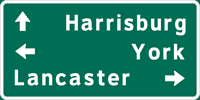 |
TRIPLE-LINE DESTINATION SIGN (D1-3) (a) Justification. The Triple-Line Destination Sign (D1-3) shall be authorized for use to indicate the direction to cities, boroughs and villages, etc. (b) Placement. The D1-3 sign should generally be placed in advance of an intersection. (c) Size. The standard size of D1-3 sign shall be 72 inches x 36 inches. The 48 inches x 24 inches size may be used on minor highways and urban streets. |
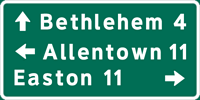 |
TRIPLE-LINE DESTINATION MILEAGE SIGN (D1-3A) (a) Justification. The Triple-Line Destination Mileage Sign (D1-3A) shall be authorized for use to indicate the direction and distance to cities, boroughs and villages, etc. (b) Placement. The D1-3A sign should generally be placed in advance of an intersection. (c) Size. The standard size of D1-3A sign shall be 72 inches x 36 inches. The 48 inches x 24 inches size may be used on minor highways and urban streets. |
| SINGLE-LINE DISTANCE SIGN (D2-1) (a) Justification. The Single-Line Distance Sign (D2-1) shall be authorized for use to indicate the name of the next significant destination point on the route and the distance to that point. (b) Placement. The D2-1 sign should be placed just beyond intersections and just beyond the limits of incorporated municipalities or at the edge of the built-up area if it extends beyond the municipal limits. (c) Size. The standard size of the D2-l sign shall be 72 inches x 12 inches. The 48 inches x 8 inches may be used on minor highways and urban streets. |
 |
DOUBLE-LINE DISTANCE SIGN (D2-2) (a) Justification. The Double-Line Distance Sign (D2-2) shall be authorized for use to indicate the names of the next two significant destination points on the route and the distance to those points. (b) Placement. The D2-2 sign should be placed just beyond intersections and just beyond the limits of incorporated municipalities or at the edge of the built-up area if it extends beyond the municipal limits. (c) Size. The standard size of the D2-2 sign shall be 72 inches x 24 inches. The 48 inches x 16 inches may be used on minor highways and urban streets. |
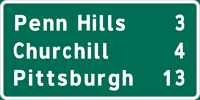 |
TRIPLE-LINE DISTANCE SIGN (D2-3) (a) Justification. The Triple-Line Distance Sign (D2-3) shall be authorized for use to indicate the names of the next three significant destination points on the route and the distance to those points. (b) Placement. The D2-3 sign should be placed just beyond intersections and just beyond the limits of incorporated municipalities or at the edge of the built-up area if it extends beyond the municipal limits. (c) Size. The standard size of the D2-3 sign shall be 72 inches x 36 inches. The 48 inches x 24 inches may be used on minor highways and urban streets. |
| STREET NAME SIGN (D3-1) The Street Name Sign (D3-1) shall be authorized for use as a post-mounted sign to identify names of streets for motorists and pedestrians. The D3-1 sign, or other official type of street name sign, should be placed at all street intersections regardless of other route marking that may be present. When the D3-1 signs are used in business districts, they should be placed at least on the diagonally opposite corners so that they will be on the far right-hand side of the intersection for traffic on the more important street. Signs naming both streets should be erected at each location. They should be mounted with their faces parallel to the streets they name, as close to the corner as practical with the nearest part of each sign not less than 1 foot, and preferably 2 feet, back from both curb lines. In residential districts, D3-1 signs should be mounted as in business districts, but a single location at each intersection shall ordinarily suffice on all but the most important thoroughfares. Lettering on post-mounted D3-1 signs should be composed of 6 inch upper-case/lower-case letters. On multi-lane streets with speed limits greater than 40 MPH, the lettering on post-mounted D3-1 signs should be composed of initial upper-case letters at least 8 inches in height and lower-case letters at least 6 inches in height. The overall width of the sign is variable. Except when necessary to avoid confusion, suffixes such as "St", "Dr", and "Rd", or sections of the city such as "NW" should not be used. When used, this supplemental lettering may be in smaller lettering, composed of 3 inch upper-case/lower-case letters. For roads functionally classified as local with speed limits of 25 MPH or less, the lettering may be 4 inch upper-case/lower-case. A pictograph may be used on a D3-1 sign. If a pictograph is used, the height and width of the pictograph shall not exceed the upper-case letter height of the principal legend of the sign. The street name sign should reflectorized or illuminated and should have a white legend on a green background, white legend on a brown background, white legend on a blue background, or black legend on a white background. Borders are not required. The same background color for D3-1 signs should be applied to all signs on roadways under the jurisdiction of a particular highway agency. |
| SINGLE-LINE ADVANCE STREET NAME SIGN (D3-2) (a) Justification. The Single-Line Advance Street Name Sign (D3-2) shall be authorized for use in advance of an intersection to identity the name of the intersecting street. Curved-stem arrows may be used on D3-2 signs on approaches to circular intersections. A single arrow may be used if the name only applies in one direction. Pictographs shall not be displayed on the D3-2 sign. (b) Size. The standard size of the D3-2 sign shall be 48 inches x 8 inches. |
 |
DOUBLE-LINE ADVANCE STREET NAME SIGN (D3-3) (a) Justification. The Double-Line Advance Street Name Sign (D3-3) shall be authorized for use in advance of an intersection to identity the names of the intersecting streets. Curved-stem arrows may be used on D3-3 signs on approaches to circular intersections. Pictographs shall not be displayed on the D3-3 sign. (b) Size. The standard size of the D3-3 sign shall be 48 inches x 16 inches. |
 |
SINGLE-LINE OVERHEAD STREET NAME SIGN (D3-4) The Single-Line Overhead Street Name Sign (D3-4) may be mounted overhead at signalized intersections to identify the name of a side road, or the name of the cross road where both legs of the cross road have the same street name. Messages should conform with the Department of Transportation's "Name Usage and Abbreviation Guide for Street Name Signs". Standard colors shall be white legend and border on a green background, but white-on-blue, white-on-brown, or black-on-white colors may used used systematically throughout the municipality. The D3-4 sign may vary in width as necessary to accommodate the required legend. The legend should be "Clearview 1W, 2W, or 3W" font, of the highest series possible. The standard size lettering is 12-inch uppercase and 9-inch lowercase. For long street names where the legend would otherwise exceed the maximum width which can be structurally or physically accommodated, the spacing between characters may be compressed up to 35 percent, as necessary. If a sign using the standard size lettering is still too large, this will serve as engineering justification for using smaller size lettering. The smallest sign may only be used on traffic signal approaches with a 25 MPH speed limit. Although a standard sign blank is not specified, 0.08 inch aluminum should be used. |
 |
SINGLE-LINE OVERHEAD STREET NAME SIGN (D3-5) The Double-Line Overhead Street Name Sign (D3-5) may be mounted overhead at signalized intersections to identify the name of the cross road where each leg of the cross road has a different street name. Standard colors shall be white legend and border on a green background, but white-on-blue, white-on-brown, or black-on-white colors may used used systematically throughout the municipality. The D3-5 sign may vary in width as necessary to accommodate the required legend. The legend should be "Clearview 1W, 2W, or 3W" font, of the highest series possible. The standard size lettering is 12-inch uppercase and 9-inch lowercase. For long street names where the legend would otherwise exceed the maximum width which can be structurally or physically accommodated, the spacing between characters may be compressed up to 35 percent, as necessary. If a sign using the standard size lettering is still too large, this will serve as engineering justification for using smaller size lettering. The smallest sign may only be used on traffic signal approaches with a 25 MPH speed limit. Although a standard sign blank is not specified, 0.08 inch aluminum should be used. |
 |
PARKING AREA SIGN (D4-1) (a) Justification. The Parking Area Sign (D4-1) shall be authorized for use in an urban area to guide traffic to a nearby public parking area, thus minimizing aimless travel on the part of drivers unacquainted with the area. Under some circumstances the sign may be useful in rural areas where crowds congregate for special events. It may also be used in rest areas to direct traffic to desired parking locations. (b) Placement. The D4-1 sign should be paced on major thoroughfares at the nearest point of access to the nearest point of access to the parking facility and elsewhere where it can help relieve the local streets of traffic seeking a place to park. Generally it should not be used more than three or four blocks from the parking area. (c) Size. The standard size of the D4-1 sign shall be 30 inches x 24 inches. The 18 inches x 15 inches size may be used on minor highways in urban areas. |
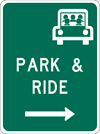 |
PARK AND RIDE SIGN (D4-2) (a) Justification. The Park And Ride Sign (D4-2) shall be authorized for use to guide motorists of "Park and Ride" facilities. If the function of the parking lot is to serve carpool riders, the carpool symbol should be used as indicated to the left. However, if the function of the parking lot is to provide parking for persons using public transportation, the transit logo should be used, and if both carpool and pubic transportation are served by the parking lot, both the logo and carpool symbol should be used. (b) Design. When the transit logo is used, it should be in its standard colors. In order to increase the target value and contrast of the logo, it may be necessary to include the logo within a white border or use a white background for the logo. In no case shall the vertical dimension of the logo exceed 18 inches. When used, the transit logo should be in the upper left corner and the carpool symbol in the upper right corner. (c) Placement. The D4-2 sign may be placed on major thoroughfares at the nearest point of access to the public parking facility and elsewhere where it can help traffic seeking the "Park and Ride" area. Generally it should not be used more than three or four blocks from the parking lot. (d) Size. The standard size of the D4-2 sign shall be 36 inches x 48 inches. The 30 inches x 36 inches may be used on minor highways or in urban areas where there is insufficient room for the standard size. |
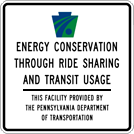 |
DEPARTMENT RIDE SHARING PARKING LOT SIGN (D4-10) The Department Ride Sharing Parking Lot Sign (D4-10) shall be authorized for use at the entrance to Department of Transportation-owned public parking lots to advise motorists of the purpose of the lot. |
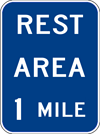 |
REST AREA (__) MILE SIGN (D5-1) (a) Justification. The Rest Area (__) Mile Sign (D5-1) shall be authorized for use in advance of a rest area where there are provided facilities for a number of vehicles to park, picnic tables, water and toilets. (b) Placement. The D5-1 sign shall be placed in advance of the rest area a distance which will permit the motorist to reduce speed and leave the highway safely if he or she desires to stop. |
 |
REST AREA ENTRANCE SIGN (D5-2) The Rest Area Entrance Sign (D5-2) shall be authorized for use at the entrance to a rest area. |
 |
ROADSIDE TABLE SIGN (D5-5A) (a) Justification. The Roadside Table Sign (D5-5A) shall be authorized for use in advance of a roadside area at which a picnic table has been placed to accommodate travelers. It should not be used in advance of a roadside rest. The D5-5-1 sign shall be mounted below this sign indicating the distance to the roadside table. (b) Placement. The D5-5A sign should be placed only on the same side of the highway as the roadside table. It should not be used to direct the motorist to a roadside table on the left of the highway where opposing traffic must be crossed. |
| (__) FEET SIGN (D5-5-1) The (__) Feet Sign (D5-5-1) shall be authorized for use below the Roadside Table Sign (D5-5A) to indicate the distance to the roadside table. The distance shall be limited to either "500 FT" or "1000 FT". |
 |
VISITOR INFO SIGN (D5-6-1) The Visitor Info Sign (D5-6-1) may be used with an advance rest area sign on a freeway or expressway to advise motorists that visitor (tourist) information is available. |
 |
VENDING MACHINES SIGN (D5-6-2) The Vending Machines Sign (D5-6-2) may be used with an advance Rest Area or Welcome Center sign on an expressway or freeway to advise motorists that vending machines are available. |
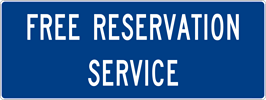 |
FREE RESERVATION SERVICE SIGN (D5-6-3) The Free Reservation Service Sign (D5-6-3) may be used with an advance welcome center sign on a freeway or expressway to advise motorists that free reservation service is available. |
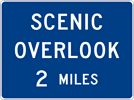 |
ADVANCE SCENIC OVERLOOK SIGN (D6-2) The Advance Scenic Overlook Sign (D6-2) shall be authorized for use in advance of an area designated by the proper authorities as a scenic overlook. The legend '"OVERLOOK" my be replaced with "AREA" or "VIEW" as appropriate. |
 |
SCENIC OVERLOOK ENTRANCE SIGN (D6-3) The Scenic Overlook Entrance Sign (D6-3) shall be authorized for use at the entrance to a scenic overlook. The legend "OVERLOOK" may be replaced with "AREA" or "VIEW" as appropriate. |

|
ATTRACTION SIGN (D7-4) (a) Justification. The Attraction Sign (D7-4) may be used on conventional highways to direct motorists to large tourist attractions in accordance with the Department of Trasportation's Attraction Signing Guidelines. One or two lines of legend may be used to identify the name or abbreviation of the attraction. (b) Design. A rectangular directional box should generally be located on the left side of the sign for attractions that are straight ahead or to the left, or on the right side of the sign for attractions to the right. The box should generally include a directional arrow and a distance of 1/4, 1/2, 3/4, or the nearest whole mile, but the box may be eliminated if it is more appropriate to use directional information such as "DRIVEWAY ON LEFT", "LEFT 1000 FEET", etc., on the second line of legend. All legend should be "Clearview 1W, 2W, or 3W" font, of the highest series possible. If necessary, the legend may be further condensed up to 35 percent. A generic symbol for hospital, campground, or airport may be used in advance of the legend message. |
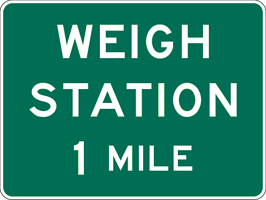 |
ADVANCE WEIGH STATION SIGN (D8-1) (a) Justification. The Advance Weigh Station Sign (D8-1) will be authorized for use in advance of a weigh station to alert the operators of trucks that a weigh station is ahead. When the weigh station is not in operation, this sign shall be folded or covered, or a subsequent sign shall be used to advise that the station is open or closed. The distance portion of the sign shall be adjusted accordingly. The maximum distance should generally be 1 MILE. (b) Size. The standard size D8-1 sign shall be 96 inches x 72 inches on freeways, 78 inches x 60 inches on expressways, and 60 inches x 48 inches on all other roadways. The 60 inches x 48 inches size may, however, be used on any type roadway for mobile or semi-permanent weighing operations. |
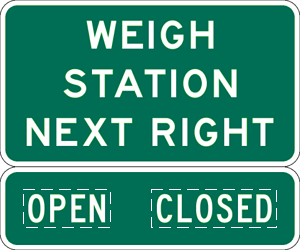 |
WEIGH STATION NEXT RIGHT SIGN (D8-2) (a) Justification. The Weigh Station Next Right Sign (D8-2) will be authorized for use in advance of the Weigh Station Sign (D8-3). The appropriate word message "OPEN" or '"CLOSED" shall be displayed by use of a changeable sign or panel. The word "LEFT' may be used in lieu of the word "RIGHT" if appropriate. When used, the D8-2 sign shall be located between the All Trucks Must Enter Station Sign (R13-1-1) and the Weigh Station Sign (D8-3). (b) Size. The standard size D8-2 sign shall be 108 inches x 90 inches for freeways, 84 inches x 72 inches for expressways, and 66 inches x 54 inches for all other roadways. The 66 inches x 54 inches size may, however, be used on any type roadway for mobile or semi-permanent weighing operations. |
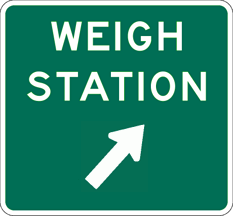 |
WEIGH STATION SIGN (D8-3) (a) Justification. The Weigh Station Sign (D8-3) will be authorized for use at the entrance to a weigh station. When the weigh station is not in operation and a Weigh Station Next Right Sign (D8-2) is not used; this sign shall be folded and covered; or the word "CLOSED" shall be displayed over the arrow. (b) Size. The standard size D8-3 sign shall be 84 inches x 78 inches on freeways, and 66 inches x 60 inches on expressways, the 48 inches x 42 inches size may, however, be used on any type roadway for mobile or semi-permanent weighing operations. |
 |
TELEPHONE WITH ARROW SIGN (D9-1A) (a) Justification. The Telephone With Arrow Sign (D9-1A) shall be authorized for use to indicate the location of public telephone facilities. Telephone company officials shall obtain approval from the proper authorities before placing this sign on any highway. The left arrow shall be used only on two-lane highways, unless the multiple lane highway has a left turn standby lane or protected left turning movement. (b) Size. The standard size of sign D9-1A shall be 24 inches x 30 inches. The 18 inches x 24 inches size may be used on urban streets. |
 |
TELEPHONE (__) SIGN (D9-1B) (a) Justification. The Telephone (__) Mile Sign (D9-1B) shall be authorized for use in advance of public telephone facilities. Telephone company officials shall obtain approval from the proper authorities before placing this sign on any highway. (b) Placement. The D9-1B sign shall be placed in advance of the telephone a distance which will permit the motorists to reduce speed and leave the highway safely if he or she desires to stop. (c) Size. The standard size of D9-1B sign shall be 24 inches x 30 inches. The 18 inches x 24 inches size may be used on urban streets. |
 |
EMERGENCY TELEPHONE SIGN (D9-1-2) The Emergency Telephone Sign (D9-1-2) is authorized to indicate the location of an emergency telephone. If the phone is adjacent to the road, the arrow may be removed and the message centered on the sign. |
 |
HOSPITAL SIGN (D9-2) (a) Justification. The Hospital Sign (D9-2) will be authorized for use to direct motorists to hospitals and other types of facilities which offer continuous emergency care with a doctor on duty 24 hours a day, seven days a week. The use of the D9-2 sign should be limited to locations in the vicinity of the hospital, trailblazing traffic from the nearest numbered traffic route or other major arterial highway. If the nearest numbered traffic route has a light average daily (ADT) of less than 1,500 vehicles, the D9-2 sign may installed on other than the nearest numbered traffic route providing the locations are within 3 miles of the hospital. The Services Arrow (D9-2-2) shall be mounted below the D9-2 sign except when the D9-2 sign is used on a freeway or prior to an interchange on an expressway. (b) Size. The use of the larger size D9-2 sign shall be reserved for use on expressways, freeways, and multi-lane highways. |
| SERVICES ARROW (D9-2-2) The Services Arrow (D9-2-2) shall be authorized for use below services signs to direct the motorist to the service indicated. |
 |
CAMPING SIGN (D9-3) (a) Justification. The Camping Sign (D9-3) is authorized for use in accordance with Department of Transportation policy. The Services Arrow (D9-2-2) may be mounted below this sign. (b) Size. The standard size of D9-3 sign shall be 24 inches x 24 inches. |
 |
GAS SYMBOL SIGN (D9-7) The Gas Symbol Sign (D9-7) may be used to direct drivers on freeways to qualifying gas facilities in accordance with Department of Transportation policy. When used as a trailblazer on an exit ramp or conventional highway, a 24 inches x 12 inches Services Arrow (D9-2-2) should be beneath the 24 inches x 24 inches size D9-7 sign. |
 |
FOOD SYMBOL SIGN (D9-8) The Food Symbol Sign (D9-8) may used to direct drivers on freeways to qualifying food establishments in accordance with Department of Transportation policy. When used as a trailblazer on an exit ramp or conventional highway, a 24 inches x 12 inches Services Arrow (D9-2-2) should be used beneath the 24 inches x 24 inches size D9-8 sign. |
 |
LODGING SYMBOL SIGN (D9-9) The Lodging Symbol Sign (D9-9) may be to direct drivers on freeways to qualifying lodging facilities in accordance with Department of Transportation policy. When used as a trailblazer on an exit ramp or conventional highway, a 24 inches x 12 inches Services Arrow (D9-2-2) should be used beneath the 24 inches x 24 inches size D9-9 sign. |
 |
VISITOR INFORMATION SYMBOL SIGN (D9-10) The Visitor Information Symbol Sign (D9-10) may be used to direct drivers to qualifying visitor (tourist) information centers in accordance with Department of Transportation policy. The 30 inches x 30 inches size should be used on the mainline of an expressway or freeway, but the border may be omitted if attached to a general motorist service panel. When used on exit ramps and conventional highways, a 24 inches x 12 inches Services Arrow (D9-2-2) should be used beneath the 24 inches x 24 inches size D9-10 sign. |
 |
DIESEL SYMBOL SIGN (D9-11) The Diesel Symbol Sign (D9-11) may used to direct drivers on freeways to qualifying diesel facilities in accordance with Department of Transportation policy. (Note: all diesel facilities must have both gas and diesel and shall be open to passenger cars). When used as a trailblazer on an exit ramp or conventional highway, a 24 inches x 12 inches Services Arrow (D9-2-2) should be used beneath the 24 inches x 24 inches size D9-11 sign. |
| TRAUMA CENTER PLAQUE (D9-13DP) The Trauma Center Plaque (D9-13DP) may be used above the Hospital Sign (D9-2) for facilities that are accredited trauma centers by the Pennsylvania Trauma Systems Foundation. |
 |
STATE POLICE SYMBOL SIGN (D9-14) The State Police Symbol Sign (D9-14) may be used to direct drivers on freeways to qualifying State Police stations in accordance with Department of Transportation policy. When used as a trailblazer on an exit ramp or conventional highway, a 24 inches x 12 inches Services Arrow (D9-2-2) should be used beneath the 24 inches x 24 inches size D9-11 sign. |
| SINGLE-DIGIT REFERENCE LOCATION SIGN (D10-1) (a) Justification. The Single-Digit Reference Location Sign (D10-1) shall be authorized for use on a highway to assist the motorist in estimating his or her progress, to provide a means for identifying the location of emergency incidents, and to aid in highway maintenance and servicing. Zero distance shall begin at the south and west state lines and at junctions where routes begin. The mileage numbering shall be continuous for each limited-access portion of a route, except when overlaps occur. With overlapped routes, continuity shall be established for only one of the routes. On the route without reference location sign continuity, the first reference location sign beyond the overlap shall indicate the total distance traveled on that route. (b) Placement. For divided highways, distance measurements shall be made on northbound and eastbound roadways. The reference location sign for southbound and westbound roadways shall be placed directly opposite. When a reference location sign cannot be placed in its correct location, it may be moved in either direction as much as 50 feet. If it cannot be placed within 50 feet of its correct location, it should be omitted. Reference location signs shall be placed so that the bottom of the sign is 4 feet above the near roadway edge. They shall be placed not less than 2 feet or more than 6 feet outside the outer edge of the shoulder. They should be placed in the same line as delineators. |
| SINGLE-DIGIT INTERMEDIATE REFERENCE LOCATION SIGN (D10-1A) The Single-Digit Intermediate Reference Location Sign (D10-1A) shall be authorized for use on a highway to assist the motorist in estimating his or her progress, to provide a means for identifying the location of emergency incidents, and to aid in highway maintenance and servicing. Zero distance shall begin at the south and west state lines and at junctions where routes begin. The mileage numbering shall be continuous for each route, except when overlaps occur. With overlapped routes, continuity shall be established for only one of the routes. On the route without reference location sign continuity, the first reference location sign beyond the overlap shall indicate the total distance traveled on that route. Placement requirements shall be the same as the Single-Digit Reference Location Sign (D10-1). |
| DOUBLE-DIGIT REFERENCE LOCATION SIGN (D10-2) (a) Justification. The Double-Digit Reference Location Sign (D10-2) shall be authorized for use on a highway to assist the motorist in estimating his or her progress, to provide a means for identifying the location of emergency incidents, and to aid in highway maintenance and servicing. Zero distance shall begin at the south and west state lines and at junctions where routes begin. The mileage numbering shall be continuous for each limited-access portion of a route, except when overlaps occur. With overlapped routes, continuity shall be established for only one of the routes. On the route without reference location sign continuity, the first reference location sign beyond the overlap shall indicate the total distance traveled on that route. (b) Placement. For divided highways, distance measurements shall be made on northbound and eastbound roadways. The reference location sign for southbound and westbound roadways shall be placed directly opposite. When a reference location sign cannot be placed in its correct location, it may be moved in either direction as much as 50 feet. If it cannot be placed within 50 feet of its correct location, it should be omitted. Reference location signs shall be placed so that the bottom of the sign is 4 feet above the near roadway edge. They shall be placed not less than 2 feet or more than 6 feet outside the outer edge of the shoulder. They should be placed in the same line as delineators. |
| DOUBLE-DIGIT INTERMEDIATE REFERENCE LOCATION SIGN (D10-2A) The Double-Digit Intermediate Reference Location Sign (D10-2A) shall be authorized for use on a highway to assist the motorist in estimating his or her progress, to provide a means for identifying the location of emergency incidents, and to aid in highway maintenance and servicing. Zero distance shall begin at the south and west state lines and at junctions where routes begin. The mileage numbering shall be continuous for each route, except when overlaps occur. With overlapped routes, continuity shall be established for only one of the routes. On the route without reference location sign continuity, the first reference location sign beyond the overlap shall indicate the total distance traveled on that route. Placement requirements shall be the same as the Double-Digit Reference Location Sign (D10-2). |
| TRIPLE-DIGIT REFERENCE LOCATION SIGN (D10-3) (a) Justification. The Triple-Digit Reference Location Sign (D10-3) shall be authorized for use on a highway to assist the motorist in estimating his or her progress, to provide a means for identifying the location of emergency incidents, and to aid in highway maintenance and servicing. Zero distance shall begin at the south and west state lines and at junctions where routes begin. The mileage numbering shall be continuous for each limited-access portion of a route, except when overlaps occur. With overlapped routes, continuity shall be established for only one of the routes. On the route without reference location sign continuity, the first reference location sign beyond the overlap shall indicate the total distance traveled on that route. (b) Placement. For divided highways, distance measurements shall be made on northbound and eastbound roadways. The reference location sign for southbound and westbound roadways shall be placed directly opposite. When a reference location sign cannot be placed in its correct location, it may be moved in either direction as much as 50 feet. If it cannot be placed within 50 feet of its correct location, it should be omitted. Reference location signs shall be placed so that the bottom of the sign is 4 feet above the near roadway edge. They shall be placed not less than 2 feet or more than 6 feet outside the outer edge of the shoulder. They should be placed in the same line as delineators. |
| TRIPLE-DIGIT INTERMEDIATE REFERENCE LOCATION SIGN (D10-3A) The Triple-Digit Intermediate Reference Location Sign (D10-3A) shall be authorized for use on a highway to assist the motorist in estimating his or her progress, to provide a means for identifying the location of emergency incidents, and to aid in highway maintenance and servicing. Zero distance shall begin at the south and west state lines and at junctions where routes begin. The mileage numbering shall be continuous for each route, except when overlaps occur. With overlapped routes, continuity shall be established for only one of the routes. On the route without reference location sign continuity, the first reference location sign beyond the overlap shall indicate the total distance traveled on that route. Placement requirements shall be the same as the Triple-Digit Reference Location Sign (D10-3). |
 |
ENHANCED REFERENCE LOCATION WITH DECIMAL SIGN (D10-5) (a) Justification. The Enhanced Reference Location with Decimal Sign (D10-5) shall be authorized for use on a highway to assist the motorist in estimating his or her progress, to provide a means for identifying the location of emergency incidents and to aid in highway maintenance and servicing. Zero distance shall begin at the south and west state lines and at junctions where routes begin. The mileage numbering shall be continuous for each limited-access portion of a route, except when overlaps occur. With overlapped routes, continuity shall be established for any one of the routes. On the route without distance marker continuity, the first distance marker beyond the overlap shall indicate the total distance traveled on that route. The Enhanced Reference Location with Decimal Sign (D10-5) shall only be used in lieu of the Distance Marker Sign (D10-1, D10-2, D10-3) where Intermediate Reference Location Signs (D10-1A, D10-2A, D10-3A) are used. It will not be used on sections of highway where Intermediate Distance Marker Signs are not used. The D10-5 sign shall display a decimal point and a zero numeral. (b) Placement. For divided highways, distance measurements shall be made on northbound and eastbound roadways. The distance marker for southbound and westbound roadways shall be placed directly opposite. When a distance marker cannot be placed in its correct location, it may be moved in either direction as much as 50 feet. If it cannot be placed within 50 feet of its correct location, it should be omitted. Distance markers shall be placed so that the bottom of the marker is 4 feet above the near roadway edge. They shall be placed not less than 2 feet or more than 6 feet outside the outer edge of the shoulder. They should be placed in the same line as delineators. |
 |
BIKE ROUTE SIGN (D11-1) (a) Justification. The Bike Route Sign (D11-1) shall be authorized for use to guide cyclists on a predetermined bike route that may be a trail, secondary road, or a combination of safe and suitable surfaces. The Information Arrow (I4-1-2) shall be mounted below this sign where the route changes direction. (b) Size. The standard size of D11-1 sign shall be 24 inches x 18 inches. |
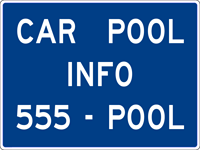 |
CAR POOL INFORMATION SIGN (D12-2) (a) Justification. The Car Pool Information Sign (D12-2) shall be authorized for use in urban areas which have carpool matching services. The message on the sign may be varied as necessary e.g., CAR-VAN POOL INFO (__), or the telephone number as shown on the last line need not have the last four digits as indicated. (b) Placement. When used, the D12-2 sign should be placed adjacent to preferential lanes or along high volume urban roads normally utilized by commuter traffic. (c) Size. The standard size D12-2 sign shall be 54 inches x 42 inches on conventional multi-lane highways and expressways, and 72 inches x 54 inches on freeways. A 36 inches x 30 inches sign may used on urban streets with restricted lateral clearance. |
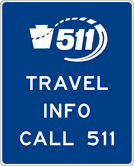 |
TRAVEL INFO CALL 511 SIGN (D12-5) The Travel Info Call 511 Sign (D12-5) may be installed where a 511 Traveler Information Services telephone number is available to road users for obtaining traffic, public transportation, weather, construction, or road condition information. |
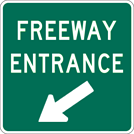 |
FREEWAY ENTRANCE LEFT SIGN (D13-3AL) The Freeway Entrance Left Sign (D13-3AL) may be used on entrance ramps near the crossroad to inform road users of the freeway entrance. |
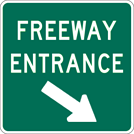 |
FREEWAY ENTRANCE RIGHT SIGN (D13-3AR) The Freeway Entrance Right Sign (D13-3AR) may be used on entrance ramps near the crossroad to inform road users of the freeway entrance. |
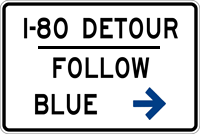 |
EMERGENCY DETOUR — FOLLOW (COLOR) ARROW SIGN (D14-101) (a) Justification. The Emergency Detour — Follow (color) Arrow Sign (D14-101) may be used along expressway and freeway off-ramps, or along conventional highways, at the beginning of an emergengy road closure in conjunction with the Emergency Detour (color) Arrow trailblazer Signs (D14-102). The traffic route should be indicated at the beginning of the first line. The last line should identify the color of the arrow in black legend, and include an arrow of the appropriate color and orientation. Appropriate colors should generally be limited to blue, orange, or back. (b) Placement. The D14-101 sign should be removed or folded when it is not appropriate. |
 |
EMERGENCY DETOUR (COLOR) TRAILBLAZER SIGN (D14-102) The Emergency Detour (color) Trailblazer Sign (D14-102) may be used following an Emergency Detour — Follow (color) Arrow Sign (D14-101) to identify necessary turns in the emergency detour route. The color of the arrow should be included on the first line of legend, and the arrow should be rotated to indicate the appropriate direction of the route. The D14-102 sign may remain in view even when the detour is not in effect. |
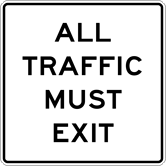 |
ALL TRAFFIC MUST EXIT SIGN (D14-103) The All Traffic Must Exit Sign (D14-103) may be used for signing emergency detours on limited access facilities to indicate that traffic must exit. The D14-103 sign should be used in conjunction with proper lane closure signs and the Emergency Detour Sign (D14-101). |
